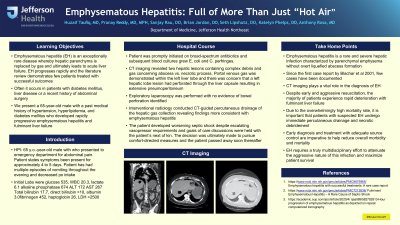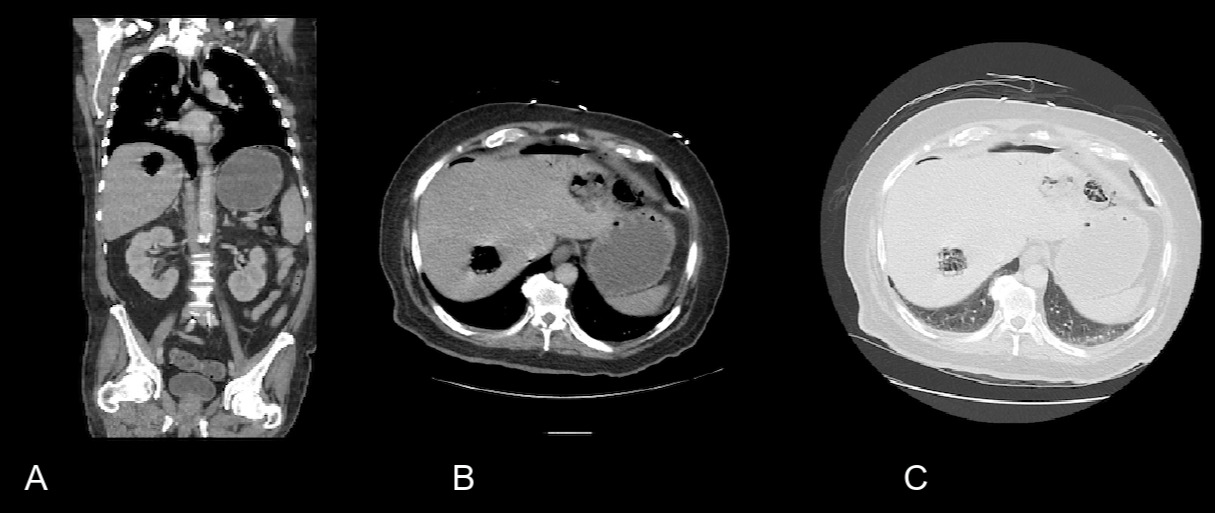Monday Poster Session
Category: Liver
P2483 - Emphysematous Hepatitis: Full of More Than Just “Hot Air”
Monday, October 23, 2023
10:30 AM - 4:15 PM PT
Location: Exhibit Hall

Has Audio

Huzaif Taufiq, MD
Jefferson Health Northeast, PA
Presenting Author(s)
Huzaif Taufiq, MD1, Pranay Reddy, MD, MPH2, Sanjay Rau, DO3, Brian Jordan, DO4, Seth Lipshutz, DO1, Katelyn Phelps, DO2, Anthony Rosa, MD5
1Jefferson Health Northeast, Philadephia, PA; 2Jefferson Health Northeast, Philadelphia, PA; 3Jefferson Health, Philadelphia, PA; 4Jefferson Torresdale, North Wales, PA; 5US Digestive Health, Bensalem, PA
Introduction: Emphysematous hepatitis (EH) is an exceptionally rare disease whereby hepatic parenchyma is replaced by gas and ultimately leads to acute liver failure. EH progresses rapidly and the literature review demonstrates few patients treated with successful outcomes. We present a 65-year-old male with a past medical history of hypertension, hyperlipidemia, and diabetes mellitus who developed rapidly progressive emphysematous hepatitis and fulminant liver failure.
Case Description/Methods: The patient presented to the emergency department with a 4-day history of right upper quadrant abdominal pain. Initial labs revealed hyperglycemia, leukocytosis, conjugated hyperbilirubinemia, and elevated aminotransferases. He was promptly initiated on broad-spectrum antibiotics and subsequent blood cultures grew E. coli and C. perfringes. CT imaging revealed two hepatic lesions containing complex debris and gas concerning abscess vs. necrotic process. Portal venous gas was demonstrated within the left liver lobe and there was concern that a left hepatic lobe lesion had perforated through the liver capsule resulting in extensive pneumoperitoneum. Exploratory laparoscopy was performed with no evidence of bowel perforation identified. Interventional radiology conducted CT-guided percutaneous drainage of the hepatic gas collection revealing findings more consistent with emphysematous hepatitis. The patient developed worsening septic shock despite escalating vasopressor requirements and goals of care discussions were held with the patient’s next of kin. The decision was ultimately made to pursue comfort-directed measures and the patient passed away soon thereafter.
Discussion: Emphysematous hepatitis is a rare and severe hepatic infection characterized by parenchymal emphysema without overt liquefied abscess formation. Since the first case report by Blachar et al 2001, few cases have been documented. CT imaging plays a vital role in the diagnosis of EH. Despite early and aggressive resuscitation, the majority of patients experience rapid deterioration with fulminant liver failure. Due to the overwhelmingly high mortality rate, it is important that patients with suspected EH undergo immediate percutaneous drainage and necrotic debridement. Early diagnosis and treatment with adequate source control are imperative to help reduce overall morbidity and mortality. EH requires a truly multidisciplinary effort to attenuate the aggressive nature of this infection and maximize patient survival.

Disclosures:
Huzaif Taufiq, MD1, Pranay Reddy, MD, MPH2, Sanjay Rau, DO3, Brian Jordan, DO4, Seth Lipshutz, DO1, Katelyn Phelps, DO2, Anthony Rosa, MD5. P2483 - Emphysematous Hepatitis: Full of More Than Just “Hot Air”, ACG 2023 Annual Scientific Meeting Abstracts. Vancouver, BC, Canada: American College of Gastroenterology.
1Jefferson Health Northeast, Philadephia, PA; 2Jefferson Health Northeast, Philadelphia, PA; 3Jefferson Health, Philadelphia, PA; 4Jefferson Torresdale, North Wales, PA; 5US Digestive Health, Bensalem, PA
Introduction: Emphysematous hepatitis (EH) is an exceptionally rare disease whereby hepatic parenchyma is replaced by gas and ultimately leads to acute liver failure. EH progresses rapidly and the literature review demonstrates few patients treated with successful outcomes. We present a 65-year-old male with a past medical history of hypertension, hyperlipidemia, and diabetes mellitus who developed rapidly progressive emphysematous hepatitis and fulminant liver failure.
Case Description/Methods: The patient presented to the emergency department with a 4-day history of right upper quadrant abdominal pain. Initial labs revealed hyperglycemia, leukocytosis, conjugated hyperbilirubinemia, and elevated aminotransferases. He was promptly initiated on broad-spectrum antibiotics and subsequent blood cultures grew E. coli and C. perfringes. CT imaging revealed two hepatic lesions containing complex debris and gas concerning abscess vs. necrotic process. Portal venous gas was demonstrated within the left liver lobe and there was concern that a left hepatic lobe lesion had perforated through the liver capsule resulting in extensive pneumoperitoneum. Exploratory laparoscopy was performed with no evidence of bowel perforation identified. Interventional radiology conducted CT-guided percutaneous drainage of the hepatic gas collection revealing findings more consistent with emphysematous hepatitis. The patient developed worsening septic shock despite escalating vasopressor requirements and goals of care discussions were held with the patient’s next of kin. The decision was ultimately made to pursue comfort-directed measures and the patient passed away soon thereafter.
Discussion: Emphysematous hepatitis is a rare and severe hepatic infection characterized by parenchymal emphysema without overt liquefied abscess formation. Since the first case report by Blachar et al 2001, few cases have been documented. CT imaging plays a vital role in the diagnosis of EH. Despite early and aggressive resuscitation, the majority of patients experience rapid deterioration with fulminant liver failure. Due to the overwhelmingly high mortality rate, it is important that patients with suspected EH undergo immediate percutaneous drainage and necrotic debridement. Early diagnosis and treatment with adequate source control are imperative to help reduce overall morbidity and mortality. EH requires a truly multidisciplinary effort to attenuate the aggressive nature of this infection and maximize patient survival.

Figure: (A) There is a well-defined gas-containing collection in the liver
(B) (C) There are at least 2 complex debris and gas containing hepatic lesions There is free intraperitoneal gas.
(B) (C) There are at least 2 complex debris and gas containing hepatic lesions There is free intraperitoneal gas.
Disclosures:
Huzaif Taufiq indicated no relevant financial relationships.
Pranay Reddy indicated no relevant financial relationships.
Sanjay Rau indicated no relevant financial relationships.
Brian Jordan indicated no relevant financial relationships.
Seth Lipshutz indicated no relevant financial relationships.
Katelyn Phelps indicated no relevant financial relationships.
Anthony Rosa indicated no relevant financial relationships.
Huzaif Taufiq, MD1, Pranay Reddy, MD, MPH2, Sanjay Rau, DO3, Brian Jordan, DO4, Seth Lipshutz, DO1, Katelyn Phelps, DO2, Anthony Rosa, MD5. P2483 - Emphysematous Hepatitis: Full of More Than Just “Hot Air”, ACG 2023 Annual Scientific Meeting Abstracts. Vancouver, BC, Canada: American College of Gastroenterology.
